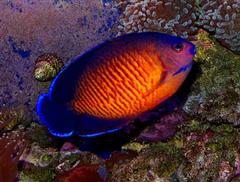Angelfish - Coral Beauty
Dusky Angelfish, Two Spined Angel Fish Scientific Name: Centropyge bispinous
Mon, 28th April, 2025 - 9:28 am GMT
Sponsor Ads:

Alternative Name
Dusky Angelfish, Two Spined Angel Fish Scientific Name: Centropyge bispinousBasic Info
At maturity, most Coral Beauty Angels are about four inches long. A deep bluish-purple shade pervades most of the upper part of their bodies, including their heads and fins. These are outlined in a brighter blue color. Spreading up from the Coral Beauty Angel's belly is a beautiful pinkish-orange blush, which covers the underside of the fish and may even be seen over the lower parts of the head. This lighter pinkish-orange color is also prevalent over the sides of the Coral Beauty Angel.
Health
A single Coral Beauty Angel Fish should have an aquarium of at least 30 gallons in volume. The temperature should remain around 78 degrees Fahrenheit (26 degrees Celsius). When kept alone, Coral Beauty Angels should be kept in a salinity range between 1.020 and 1.025. Although the lower part of this range is preferred for a fish-only aquarium, in an enclosure with invertebrates the salinity should be at least 1.023. This is because higher salinities are needed to keep invertebrates healthy. A pH value of 8.3 or 8.4 is ideal. Plenty of hiding places should be available for your Coral Beauty Angel. Although some Coral Beauty Angels may get along with other fish, they are territorial and may not get along with other smaller Angels. Coral Beauty Angels may also show tendencies to nibble on invertebrates in their enclosures, so they should be monitored. Coral Beauty Angel Fish usually do best when they are fed a wide variety of foods. Items like mysis shrimp and flake food are standard offerings, supplemented with a number of other protein and vegetative items. Often, Coral Beauty Angel Fish will nibble at algal growth in their enclosures. To select a healthy Coral Beauty Angel, be sure to choose a brightly colored specimen that is active and alert, and that has no injuries or damage on its body. Usually, it is best to keep the fish in conditions of low light with plenty of hiding places until it has been acclimated to your enclosure. Breeding Coral Beauty Angels begin their lives as an indeterminate sex, before becoming female. Females may turn into males as they develop. In a group of females without a male, an adult female may become a male. Many Coral Beauty Angels breed when one releases a gamete, or sex cell, which induces a courtship display of swimming, then spawning, then chasing each other. Because the fry of most Angels are planktonic in nature, they have proven extremely difficult to raise.Habitat
Saltwater fishBehavior
One of the more hardy varieties of Angel Fish, Coral Beauty Angels could make an attractive fish for a saltwater aquarist wishing to begin keeping Angel Fish. These lovely fish can add to the beauty of any saltwater tank, with their intense shades of beautiful coloring. The Coral Beauty Angel can be kept with most other fish. They should be kept in a tank large enough for each fish to have a territory that does not overlap with those of other dwarf angels. If the enclosure is too small, these fish may act aggressively toward each other, and they normally do not tolerate other Dwarf Angels. Coral Beauty Angels seem to be one of the more hardy varieties of Angel Fish. They may nip at invertebrates in a reef environment, so they should be carefully watched. Many Coral Beauty Angels spend little time in hiding, making them visible in your aquarium to amuse you with their beauty and activity.Origin
Indo-PacificHistory
The Coral Beauty Angel is most commonly found in the Indo Pacific but ranges from East Africa to the Philippine Islands. Many Coral Beauty Angels seen in the pet trade are collected from Fiji.Common Foods
N/ASponsor Ads:
Everyone has a scheme for getting rich that will not work. -- Unknown
Angelfish - Coral Beauty
Coded by: BGID® | ALL RIGHTS RESERVED Copyright © 2000-2025
Disclaimer | Privacy | Report Errors / Contact | Credits








 Why haven't we as a collective earth met with aliens yet?
Why haven't we as a collective earth met with aliens yet?  The Best Text Adventure You Will Ever Play! The official site:
The Best Text Adventure You Will Ever Play! The official site:  Homosexual behavior stems from the mind or genetics?
Homosexual behavior stems from the mind or genetics?  World EcoSystem - Biodiversity Changes - Who is on board and who isn
World EcoSystem - Biodiversity Changes - Who is on board and who isn  Mouthwash - Mouthrinse - Mouth Sores - Healing Infections - Gingivitis
Mouthwash - Mouthrinse - Mouth Sores - Healing Infections - Gingivitis  Treatment for Depression
Treatment for Depression  Ultra radical and violent Islamist group that even rivals Al Qaeda
Ultra radical and violent Islamist group that even rivals Al Qaeda  An idea to have teachers who want to carry guns to school undergo some level of police training will be left up to local school districts and police departments.
An idea to have teachers who want to carry guns to school undergo some level of police training will be left up to local school districts and police departments.